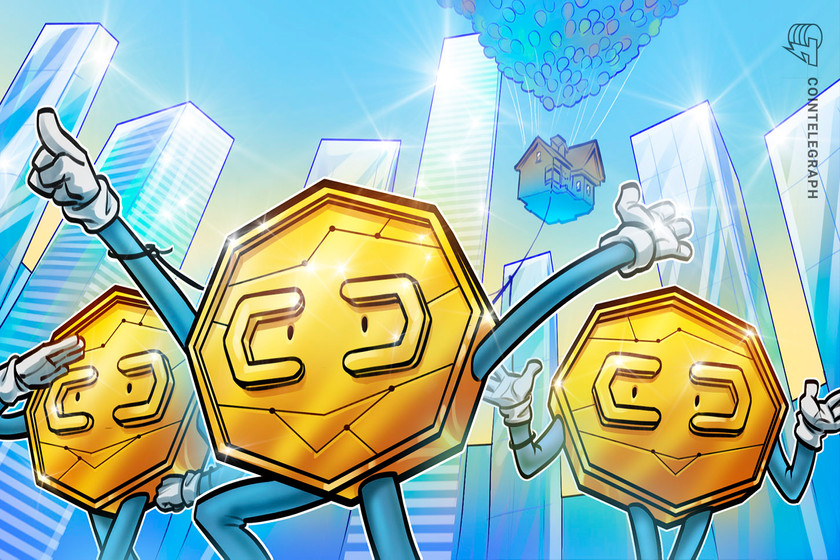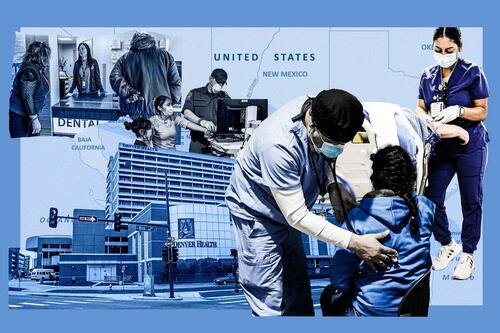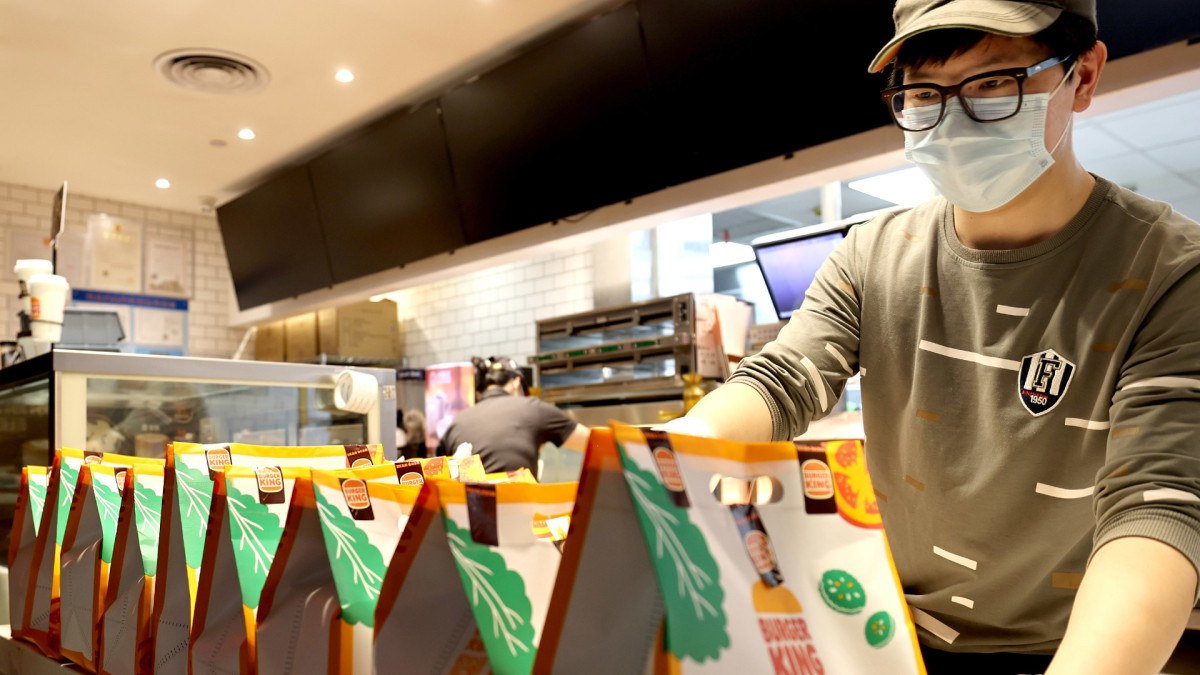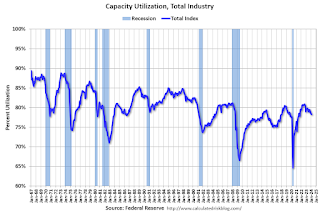How to preserve capital during inflation using cryptocurrencies?
As major economies of the world grapple with high inflation, investors could protect their savings from value erosion by investing in stablecoins.
…

As major economies of the world grapple with high inflation, investors could protect their savings from value erosion by investing in stablecoins.
Just when the global economy largely recovered from the crippling effects of the COVID-19 pandemic, geopolitical tensions and the resultant supply chain pressures have once again roiled financial markets across the world.
Furthermore, inflation has once again reared its ugly head, forcing central banks across major economies to raise interest rates in an attempt to curtail runaway prices of essential commodities like food and fuel.
Despite these efforts, developed economies like the United States and the United Kingdom continue to report inflation at multi-year highs, adding even more stress on household savings and negatively impacting consumer spending.
Apart from the threat of a looming recession, these inflationary pressures have a negative impact on the value of fiat money in the hands of consumers and highlight the need for financial tools or assets that can act as a hedge against inflation.
Impact of current inflation on the global economy
Along with its impact on the purchasing power of a country’s fiat currency, inflation has a detrimental effect on the true returns generated by financial instruments, especially if the inflation rate exceeds the rate of return on investment.
Take, for example, the S&P 500 index, which comprises the top 500 publicly traded companies in the USA and acts as the benchmark index for the country’s stock markets. Having generated an average annualized return of 11.82% since its inception in 1928, this index’s performance can seem quite spectacular at the outset.
However, with the Consumer Price Index (CPI) climbing to a 40-year high of 9.1% in June 2022, the returns generated from investments made in mutual funds that mimic this index will be significantly lower.
In fact, the index has provided an inflation-adjusted historic annual average return of just 8.5%, that too when the average CPI has been much lower than the currently reported numbers.
Moreover, as the Federal Open Market Committee (FOMC) voted to increase the US Federal Reserve’s interest rate to a four-year high of 2.25% in July 2022, the U.S. dollar has appreciated significantly against a basket of fiat currencies including the euro, the Great British pound and the Japanese yen.
While this has helped soften the prices of commodities like crude oil, it has a negative impact on the value of investments made by US citizens and companies at large in these economies.
For savvy investors allocating capital toward emerging markets like Brazil, India and China, among others, the devaluation of these countries’ fiat currencies against the USD has only served to diminish returns on investments made in these markets.
What does inflation mean for cryptocurrency?
As compared to fiat currencies, cryptocurrencies like Bitcoin (BTC) have generated stellar returns for early-stage crypto investors. While the USD index has appreciated around 8% since August 2019, BTC has returned ~240% in the same period as per current prices.
This is despite BTC correcting by ~60% from its peak in November 2021, further alluding to its long-term wealth creation potential. It can even be said that Bitcoin can protect people from the negative effects of inflation.
Related: Bitcoin and inflation: Everything you need to know
A similar trend can be seen among other popular cryptocurrencies like Ether (ETH), BNB Coin (BNB) and Ripple (XRP), hinting at cryptocurrencies being a good investment during periods of high inflation with the potential to generate inflation-beating retirement savings.
Obviously, it is important to note that cryptocurrencies display much higher volatility compared with fiat currencies and are considered to be assets rather than pure currencies. Another aspect that favors cryptocurrencies like BTC is their limited token supply.
With the original developer team setting Bitcoin’s maximum supply at 21 million BTC, it isn’t subject to the seemingly discretionary way in which fiat currencies like the USD are printed.
This implies that under no circumstance will the number of BTCs in supply exceed the set limit, thus boding well for its long-term price appreciation potential. Even for cryptocurrencies like ETH that do not have a prescribed maximum supply limit, the mechanism of minting new tokens is based on code and computational work performed.
No entity can mint ETH tokens without having created a new block on the Ethereum blockchain and the block reward mechanism depends on set factors like the complexity of calculations performed by miners.
Compare this with the arbitrary way in which the U.S. Federal Reserve or any other Central bank in the world prints money and it is evident that cryptocurrencies operate in a much more transparent and democratic way.
Are stablecoins a hedge against inflation?
Among the broader cryptocurrency market, there are a growing number of crypto tokens being launched that are being specifically created to offer a better alternative to fiat currencies.
Known as stablecoins, these cryptocurrencies are pegged to other traditional assets like the USD and gold, with their prices held stable by maintaining reserves equivalent in value to the number of tokens in supply.
While some stablecoins are also backed by algorithms or are pegged to another cryptocurrency native to the same blockchain protocol, they all aim to provide crypto investors with a medium of exchange that can be transacted freely across geographical borders.
Compared with fiat currencies or commodities such as gold, stablecoins are potentially better suited because:

This is especially important for people native to countries like Turkey, Argentina, Ethiopia, Zimbabwe, or Lebanon, where hyperinflation has deemed their fiat currencies a risky medium of exchange. Typically used to describe a monthly inflation rate exceeding 50%, hyperinflation refers to a situation when there is an expeditious and uncontrollable price increase of important goods and services in an economy.
As hyperinflation continues to erode the value of their currencies, people in such countries could switch over to stablecoins such as Tether (USDT), USD Coin (USDC) or Binance USD (BUSD) in order to protect their capital from rapid wealth erosion.
By holding their savings in the form of stablecoins, they could preserve capital during inflation using cryptocurrencies and also benefit from the appreciation in the underlying peg to even increase the value of their savings.
Since this is sacrosanct even in a high inflation and interest rate regime, hyperinflation has minimal effect on cryptocurrencies like stablecoins. Thus, for investors in economies plagued by high inflation, cryptocurrencies can act as an optimal investment, too.
Is it a good idea to put your money in crypto during inflation?
While there have been cases of cryptocurrencies failing miserably because of security concerns, fraud, or a combination of both, there are many cryptocurrencies that have stood the test of time and continue to attract hordes of investors.
Related: How can third-world countries counter inflation using Bitcoin?
Apart from BTC and ETH, altcoins such as Avalanche (AVAX) and Polygon (MATIC), among others, could be a long-term hedge against inflation. Investors could allocate some capital toward these cryptocurrencies to potentially reap profits in the long term while also using products such as staking pools to earn additional income from these investments.
Going by historic data, it can also be a profitable strategy to prudently invest in cryptocurrencies that are currently trading near important support levels and simply hold them as a hedge against inflation.
On the other hand, stablecoins, along with other cryptocurrencies, can be held in a digital or hardware wallet just like fiat currency in a traditional bank while still helping investors to protect their wealth from eroding in a hyperinflationary environment.
In other words, stablecoins are safe from inflation as compared to currencies such as the Turkish lira, especially when they are pegged against the USD. That being said, there are a few stablecoins that have been notorious for trading below their peg, and investors would do well to maintain a cautious approach when trading or investing in them.
Purchase a licence for this article. Powered by SharpShark.
sp 500 emerging markets pandemic covid-19 cryptocurrency bitcoin ethereum blockchain crypto btc xrp bnb currencies pound euro crypto commodities stock markets gold oilInternational
Illegal Immigrants Leave US Hospitals With Billions In Unpaid Bills
Illegal Immigrants Leave US Hospitals With Billions In Unpaid Bills
By Autumn Spredemann of The Epoch Times
Tens of thousands of illegal…

By Autumn Spredemann of The Epoch Times
Tens of thousands of illegal immigrants are flooding into U.S. hospitals for treatment and leaving billions in uncompensated health care costs in their wake.
The House Committee on Homeland Security recently released a report illustrating that from the estimated $451 billion in annual costs stemming from the U.S. border crisis, a significant portion is going to health care for illegal immigrants.
With the majority of the illegal immigrant population lacking any kind of medical insurance, hospitals and government welfare programs such as Medicaid are feeling the weight of these unanticipated costs.
Apprehensions of illegal immigrants at the U.S. border have jumped 48 percent since the record in fiscal year 2021 and nearly tripled since fiscal year 2019, according to Customs and Border Protection data.
Last year broke a new record high for illegal border crossings, surpassing more than 3.2 million apprehensions.
And with that sea of humanity comes the need for health care and, in most cases, the inability to pay for it.
In January, CEO of Denver Health Donna Lynne told reporters that 8,000 illegal immigrants made roughly 20,000 visits to the city’s health system in 2023.
The total bill for uncompensated care costs last year to the system totaled $140 million, said Dane Roper, public information officer for Denver Health. More than $10 million of it was attributed to “care for new immigrants,” he told The Epoch Times.
Though the amount of debt assigned to illegal immigrants is a fraction of the total, uncompensated care costs in the Denver Health system have risen dramatically over the past few years.
The total uncompensated costs in 2020 came to $60 million, Mr. Roper said. In 2022, the number doubled, hitting $120 million.
He also said their city hospitals are treating issues such as “respiratory illnesses, GI [gastro-intenstinal] illnesses, dental disease, and some common chronic illnesses such as asthma and diabetes.”
“The perspective we’ve been trying to emphasize all along is that providing healthcare services for an influx of new immigrants who are unable to pay for their care is adding additional strain to an already significant uncompensated care burden,” Mr. Roper said.
He added this is why a local, state, and federal response to the needs of the new illegal immigrant population is “so important.”
Colorado is far from the only state struggling with a trail of unpaid hospital bills.

Dr. Robert Trenschel, CEO of the Yuma Regional Medical Center situated on the Arizona–Mexico border, said on average, illegal immigrants cost up to three times more in human resources to resolve their cases and provide a safe discharge.
“Some [illegal] migrants come with minor ailments, but many of them come in with significant disease,” Dr. Trenschel said during a congressional hearing last year.
“We’ve had migrant patients on dialysis, cardiac catheterization, and in need of heart surgery. Many are very sick.”
He said many illegal immigrants who enter the country and need medical assistance end up staying in the ICU ward for 60 days or more.
A large portion of the patients are pregnant women who’ve had little to no prenatal treatment. This has resulted in an increase in babies being born that require neonatal care for 30 days or longer.
Dr. Trenschel told The Epoch Times last year that illegal immigrants were overrunning healthcare services in his town, leaving the hospital with $26 million in unpaid medical bills in just 12 months.
ER Duty to Care
The Emergency Medical Treatment and Labor Act of 1986 requires that public hospitals participating in Medicare “must medically screen all persons seeking emergency care … regardless of payment method or insurance status.”
The numbers are difficult to gauge as the policy position of the Centers for Medicare & Medicaid Services (CMS) is that it “will not require hospital staff to ask patients directly about their citizenship or immigration status.”
In southern California, again close to the border with Mexico, some hospitals are struggling with an influx of illegal immigrants.
American patients are enduring longer wait times for doctor appointments due to a nursing shortage in the state, two health care professionals told The Epoch Times in January.
A health care worker at a hospital in Southern California, who asked not to be named for fear of losing her job, told The Epoch Times that “the entire health care system is just being bombarded” by a steady stream of illegal immigrants.
“Our healthcare system is so overwhelmed, and then add on top of that tuberculosis, COVID-19, and other diseases from all over the world,” she said.

A newly-enacted law in California provides free healthcare for all illegal immigrants residing in the state. The law could cost taxpayers between $3 billion and $6 billion per year, according to recent estimates by state and federal lawmakers.
In New York, where the illegal immigration crisis has manifested most notably beyond the southern border, city and state officials have long been accommodating of illegal immigrants’ healthcare costs.
Since June 2014, when then-mayor Bill de Blasio set up The Task Force on Immigrant Health Care Access, New York City has worked to expand avenues for illegal immigrants to get free health care.
“New York City has a moral duty to ensure that all its residents have meaningful access to needed health care, regardless of their immigration status or ability to pay,” Mr. de Blasio stated in a 2015 report.
The report notes that in 2013, nearly 64 percent of illegal immigrants were uninsured. Since then, tens of thousands of illegal immigrants have settled in the city.
“The uninsured rate for undocumented immigrants is more than three times that of other noncitizens in New York City (20 percent) and more than six times greater than the uninsured rate for the rest of the city (10 percent),” the report states.
The report states that because healthcare providers don’t ask patients about documentation status, the task force lacks “data specific to undocumented patients.”
Some health care providers say a big part of the issue is that without a clear path to insurance or payment for non-emergency services, illegal immigrants are going to the hospital due to a lack of options.
“It’s insane, and it has been for years at this point,” Dana, a Texas emergency room nurse who asked to have her full name omitted, told The Epoch Times.
Working for a major hospital system in the greater Houston area, Dana has seen “a zillion” migrants pass through under her watch with “no end in sight.” She said many who are illegal immigrants arrive with treatable illnesses that require simple antibiotics. “Not a lot of GPs [general practitioners] will see you if you can’t pay and don’t have insurance.”
She said the “undocumented crowd” tends to arrive with a lot of the same conditions. Many find their way to Houston not long after crossing the southern border. Some of the common health issues Dana encounters include dehydration, unhealed fractures, respiratory illnesses, stomach ailments, and pregnancy-related concerns.
“This isn’t a new problem, it’s just worse now,” Dana said.

Medicaid Factor
One of the main government healthcare resources illegal immigrants use is Medicaid.
All those who don’t qualify for regular Medicaid are eligible for Emergency Medicaid, regardless of immigration status. By doing this, the program helps pay for the cost of uncompensated care bills at qualifying hospitals.
However, some loopholes allow access to the regular Medicaid benefits. “Qualified noncitizens” who haven’t been granted legal status within five years still qualify if they’re listed as a refugee, an asylum seeker, or a Cuban or Haitian national.
Yet the lion’s share of Medicaid usage by illegal immigrants still comes through state-level benefits and emergency medical treatment.
A Congressional report highlighted data from the CMS, which showed total Medicaid costs for “emergency services for undocumented aliens” in fiscal year 2021 surpassed $7 billion, and totaled more than $5 billion in fiscal 2022.
Both years represent a significant spike from the $3 billion in fiscal 2020.
An employee working with Medicaid who asked to be referred to only as Jennifer out of concern for her job, told The Epoch Times that at a state level, it’s easy for an illegal immigrant to access the program benefits.
Jennifer said that when exceptions are sent from states to CMS for approval, “denial is actually super rare. It’s usually always approved.”
She also said it comes as no surprise that many of the states with the highest amount of Medicaid spending are sanctuary states, which tend to have policies and laws that shield illegal immigrants from federal immigration authorities.
Moreover, Jennifer said there are ways for states to get around CMS guidelines. “It’s not easy, but it can and has been done.”
The first generation of illegal immigrants who arrive to the United States tend to be healthy enough to pass any pre-screenings, but Jennifer has observed that the subsequent generations tend to be sicker and require more access to care. If a family is illegally present, they tend to use Emergency Medicaid or nothing at all.
The Epoch Times asked Medicaid Services to provide the most recent data for the total uncompensated care that hospitals have reported. The agency didn’t respond.
Continue reading over at The Epoch Times
Uncategorized
Fast-food chain closes restaurants after Chapter 11 bankruptcy
Several major fast-food chains recently have struggled to keep restaurants open.

Competition in the fast-food space has been brutal as operators deal with inflation, consumers who are worried about the economy and their jobs and, in recent months, the falling cost of eating at home.
Add in that many fast-food chains took on more debt during the covid pandemic and that labor costs are rising, and you have a perfect storm of problems.
It's a situation where Restaurant Brands International (QSR) has suffered as much as any company.
Related: Wendy's menu drops a fan favorite item, adds something new
Three major Burger King franchise operators filed for bankruptcy in 2023, and the chain saw hundreds of stores close. It also saw multiple Popeyes franchisees move into bankruptcy, with dozens of locations closing.
RBI also stepped in and purchased one of its key franchisees.
"Carrols is the largest Burger King franchisee in the United States today, operating 1,022 Burger King restaurants in 23 states that generated approximately $1.8 billion of system sales during the 12 months ended Sept. 30, 2023," RBI said in a news release. Carrols also owns and operates 60 Popeyes restaurants in six states."
The multichain company made the move after two of its large franchisees, Premier Kings and Meridian, saw multiple locations not purchased when they reached auction after Chapter 11 bankruptcy filings. In that case, RBI bought select locations but allowed others to close.
Image source: Chen Jianli/Xinhua via Getty
Another fast-food chain faces bankruptcy problems
Bojangles may not be as big a name as Burger King or Popeye's, but it's a popular chain with more than 800 restaurants in eight states.
"Bojangles is a Carolina-born restaurant chain specializing in craveable Southern chicken, biscuits and tea made fresh daily from real recipes, and with a friendly smile," the chain says on its website. "Founded in 1977 as a single location in Charlotte, our beloved brand continues to grow nationwide."
Like RBI, Bojangles uses a franchise model, which makes it dependent on the financial health of its operators. The company ultimately saw all its Maryland locations close due to the financial situation of one of its franchisees.
Unlike. RBI, Bojangles is not public — it was taken private by Durational Capital Management LP and Jordan Co. in 2018 — which means the company does not disclose its financial information to the public.
That makes it hard to know whether overall softness for the brand contributed to the chain seeing its five Maryland locations after a Chapter 11 bankruptcy filing.
Bojangles has a messy bankruptcy situation
Even though the locations still appear on the Bojangles website, they have been shuttered since late 2023. The locations were operated by Salim Kakakhail and Yavir Akbar Durranni. The partners operated under a variety of LLCs, including ABS Network, according to local news channel WUSA9.
The station reported that the owners face a state investigation over complaints of wage theft and fraudulent W2s. In November Durranni and ABS Network filed for bankruptcy in New Jersey, WUSA9 reported.
"Not only do former employees say these men owe them money, WUSA9 learned the former owners owe the state, too, and have over $69,000 in back property taxes."
Former employees also say that the restaurant would regularly purchase fried chicken from Popeyes and Safeway when it ran out in their stores, the station reported.
Bojangles sent the station a comment on the situation.
"The franchisee is no longer in the Bojangles system," the company said. "However, it is important to note in your coverage that franchisees are independent business owners who are licensed to operate a brand but have autonomy over many aspects of their business, including hiring employees and payroll responsibilities."
Kakakhail and Durranni did not respond to multiple requests for comment from WUSA9.
bankruptcy pandemicUncategorized
Industrial Production Increased 0.1% in February
From the Fed: Industrial Production and Capacity Utilization
Industrial production edged up 0.1 percent in February after declining 0.5 percent in January. In February, the output of manufacturing rose 0.8 percent and the index for mining climbed 2.2 p…

Industrial production edged up 0.1 percent in February after declining 0.5 percent in January. In February, the output of manufacturing rose 0.8 percent and the index for mining climbed 2.2 percent. Both gains partly reflected recoveries from weather-related declines in January. The index for utilities fell 7.5 percent in February because of warmer-than-typical temperatures. At 102.3 percent of its 2017 average, total industrial production in February was 0.2 percent below its year-earlier level. Capacity utilization for the industrial sector remained at 78.3 percent in February, a rate that is 1.3 percentage points below its long-run (1972–2023) average.Click on graph for larger image.
emphasis added
This graph shows Capacity Utilization. This series is up from the record low set in April 2020, and above the level in February 2020 (pre-pandemic).
Capacity utilization at 78.3% is 1.3% below the average from 1972 to 2022. This was below consensus expectations.
Note: y-axis doesn't start at zero to better show the change.
 The second graph shows industrial production since 1967.
The second graph shows industrial production since 1967.Industrial production increased to 102.3. This is above the pre-pandemic level.
Industrial production was above consensus expectations.
-

 Uncategorized3 weeks ago
Uncategorized3 weeks agoAll Of The Elements Are In Place For An Economic Crisis Of Staggering Proportions
-

 International1 week ago
International1 week agoEyePoint poaches medical chief from Apellis; Sandoz CFO, longtime BioNTech exec to retire
-

 Uncategorized4 weeks ago
Uncategorized4 weeks agoCalifornia Counties Could Be Forced To Pay $300 Million To Cover COVID-Era Program
-

 Uncategorized3 weeks ago
Uncategorized3 weeks agoApparel Retailer Express Moving Toward Bankruptcy
-

 Uncategorized4 weeks ago
Uncategorized4 weeks agoIndustrial Production Decreased 0.1% in January
-

 International1 week ago
International1 week agoWalmart launches clever answer to Target’s new membership program
-

 Spread & Containment2 days ago
Spread & Containment2 days agoIFM’s Hat Trick and Reflections On Option-To-Buy M&A
-

 Uncategorized4 weeks ago
Uncategorized4 weeks agoRFK Jr: The Wuhan Cover-Up & The Rise Of The Biowarfare-Industrial Complex





















